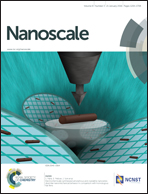Magnetic hydroxyapatite nanoworms for magnetic resonance diagnosis of acute hepatic injury†
Abstract
Inorganic non-metallic biomaterials, including the silicon frustule of a unicellular diatom, the carbonate shell of a mollusk and the calcium skeleton of the vertebrate, which are the main constituent part of an organism, serve as the supportive and protective components of soft tissue. Among them, hydroxyapatite, which primarily makes up the enamel and bone, is widely used in tissue engineering. Recently, the inorganic nonmetallic biomaterials, especially the applications of hydroxyapatites have attracted great attention. Herein, we report a novel synthesis method of magnetic functionalized hydroxyapatite nanocomposites. By simply tuning the ratios of reactants, a series of hydroxyapatite-Fe3O4 worm-shaped nanocomposites (HAP-ION nanoworms) are obtained. In addition, layer-by-layer surface modifications with chitosan (CH) and sodium alginate (SA) were employed to improve the solubility and biocompatibility, and low cytotoxicity and no hemolysis were observed. With the increase of iron oxide nanocrystals, the magnetic properties of the magnetic assembled nanoworms were enhanced, which resulted in better performance of magnetic resonance (MR) imaging. Owing to the intravenous injection of HAP-ION nanoworms, the contrast to noise ratio (CNR) of hepatic MR imaging in vivo was enhanced obviously, which should be beneficial for hepatic injury grading and further therapeutic treatment.


 Please wait while we load your content...
Please wait while we load your content...